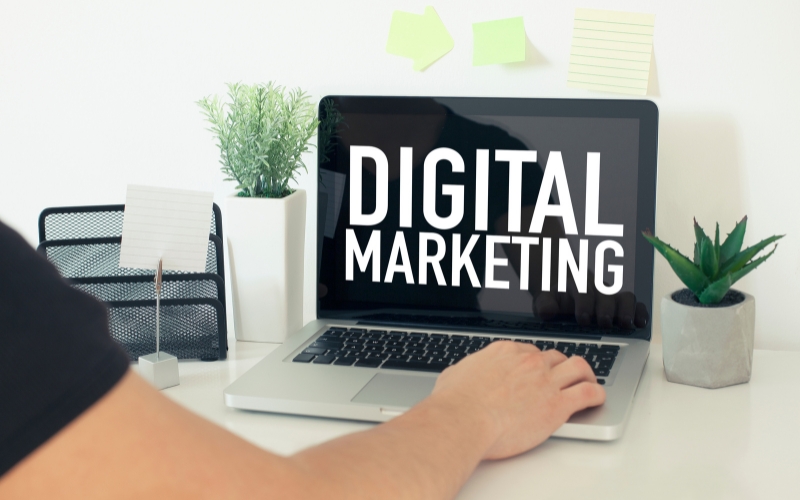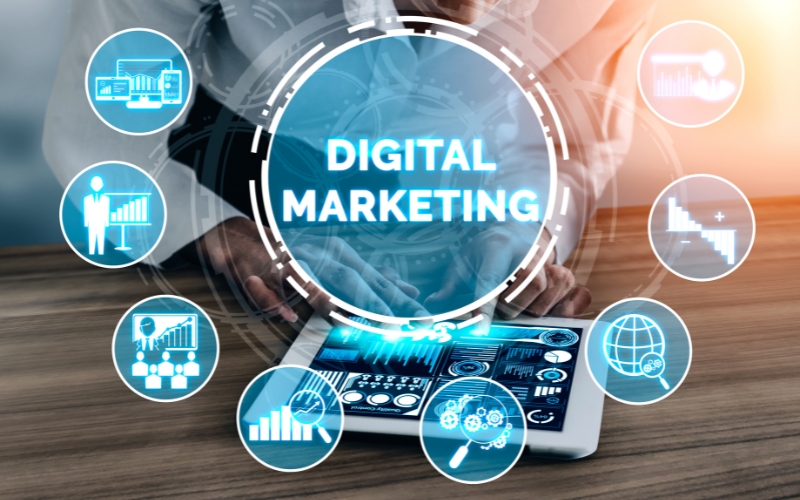In today’s digital-first world, the way businesses market their products and services has drastically changed. What is Digital Marketing has emerged as an essential tool for reaching and engaging audiences, offering countless opportunities to grow and scale. From optimizing websites for search engines to leveraging social media platforms for customer engagement, What is Digital Marketing encompasses a wide range of strategies tailored to modern consumer behavior. Whether you’re a small business looking to gain local visibility or a large organization aiming for global outreach, understanding digital marketing is the first step toward unlocking your business’s full potential. This guide breaks down what digital marketing is, its key components, and how beginners can embark on a successful digital marketing journey.
Understanding Digital Marketing: Definition and Importance

What is Digital Marketing? It encompasses all marketing efforts leveraging digital channels such as websites, social media, search engines, email, and mobile apps to connect with current and potential customers. At its core, What is Digital Marketing uses technology to execute, monitor, and optimize marketing campaigns in real-time, enabling businesses to reach their audiences more effectively and efficiently.
Definition of Digital Marketing
In simple terms, What is Digital Marketing? It is the promotion of products, services, or brands using digital technologies. Unlike traditional marketing methods such as print ads, TV commercials, or billboards, What is Digital Marketing operates in an interactive and measurable digital environment. This allows businesses to engage directly with their audience, build relationships, and drive specific actions, such as visiting a website, signing up for a newsletter, or making a purchase.
For example, a small retail store in Mumbai can use social media platforms like Instagram or Facebook to showcase its products and connect with local customers. This approach not only increases visibility but also fosters a direct line of communication with potential buyers.
The Role of Digital Marketing in a Digital-First World
In today’s interconnected world, What is Digital Marketing plays a pivotal role in shaping how businesses operate and communicate. As more consumers rely on the internet for information, shopping, and entertainment, businesses must meet their audience where they are—online.
Digital marketing levels the playing field for businesses of all sizes. A startup or small business can compete with larger corporations by creating well-targeted and cost-effective campaigns. For instance, a well-executed Google Ads campaign can place a small local business on the same page as industry giants, ensuring visibility to the right audience.
Moreover, What is Digital Marketing provides data-driven insights that traditional methods cannot. Tools like Google Analytics and social media analytics offer detailed information about customer behavior, preferences, and engagement patterns. These insights enable businesses to tailor their strategies, making their campaigns more effective and personalized.
Why Businesses of All Sizes Should Embrace Digital Marketing

- Wider Reach: Traditional marketing is often limited by geography. What is Digital Marketing? It is the strategy that eliminates these boundaries, allowing businesses to reach a global audience. Whether through a website, email campaigns, or social media, businesses can connect with customers anywhere in the world.
- Cost-Effectiveness: Compared to traditional methods, What is Digital Marketing? It’s a significantly more affordable option. For instance, running a social media ad campaign costs a fraction of what a TV commercial would, yet it can reach a highly specific audience with better engagement.
- Measurable Results: One of the standout advantages of What is Digital Marketing is its ability to provide real-time analytics. Businesses can track every aspect of their campaign performance—clicks, impressions, conversions—and adjust strategies accordingly. This level of precision ensures a better return on investment (ROI).
- Customer Engagement: Digital marketing fosters direct interaction with customers through channels like social media, email, and chatbots. Understanding What is Digital Marketing helps businesses foster this interaction, building trust and loyalty, which are critical for long-term success.
In summary, digital marketing is no longer optional; it is a necessity for any business aiming to thrive in today’s digital economy. By embracing What is Digital Marketing, businesses can connect with their audiences in meaningful ways, drive growth, and stay competitive in an ever-evolving marketplace. Whether you’re a small business owner or a marketing professional, understanding and utilizing digital marketing effectively can transform your approach to reaching customers.
Key Components of Digital Marketing

What is Digital Marketing? Digital marketing is an umbrella term that encompasses a variety of strategies and channels aimed at reaching target audiences online. Each channel serves a unique purpose and, when used together, creates a cohesive marketing strategy that drives engagement, builds brand awareness, and generates leads or sales. Here are the key components of digital marketing and how they contribute to a successful strategy:
1. Search Engine Optimization (SEO)
SEO is the foundation of digital marketing. It involves optimizing a website to rank higher in search engine results pages (SERPs) for relevant keywords. The goal is to increase organic traffic, making it easier for potential customers to find your business when searching for related products or services. Businesses aiming to succeed online must first answer: What is Digital Marketing, and how can SEO enhance its effectiveness?
Key aspects of SEO include:
- On-Page SEO: Optimizing content, meta tags, and headers for target keywords.
- Off-Page SEO: Building backlinks to improve website authority.
- Technical SEO: Enhancing website speed, mobile responsiveness, and crawlability.
Using tools like Google Analytics, SEMrush, and Ahrefs, businesses can effectively track keyword performance, gain insights, and better understand What is Digital Marketing in practice, enabling them to refine their strategies.
2. Pay-Per-Click Advertising (PPC)
PPC advertising is a key component of What is Digital Marketing, allowing businesses to place ads on platforms like Google, Facebook, and Instagram. Advertisers pay a fee each time their ad is clicked, ensuring a performance-based approach. PPC is ideal for driving immediate traffic and conversions.
Google Ads is a popular PPC platform, enabling businesses to target specific keywords and demographics. For example, a Mumbai-based clothing store could use Google Ads to appear at the top of search results when users search for “designer clothes in Mumbai.” Understanding What is Digital Marketing can help businesses effectively implement retargeting ads, which show ads to users who have previously interacted with your website, as another effective PPC tactic.
3. Social Media Marketing (SMM)
Social media platforms like Facebook, Instagram, LinkedIn, and Twitter are vital for engaging with audiences and building brand awareness. What is Digital Marketing encompasses strategies like social media marketing, which focuses on creating and sharing content that resonates with the target audience, fostering relationships, and driving website traffic.
Each platform serves different purposes:
- Facebook and Instagram: Great for visual content and targeting diverse audiences.
- LinkedIn: Ideal for B2B marketing and professional networking.
- Twitter: Perfect for real-time updates and customer engagement.
Tools like Hootsuite and Buffer help manage and schedule posts, while analytics tools provide insights into audience engagement and campaign performance, a crucial part of answering What is Digital Marketing effectively
4. Email Marketing
Email marketing remains one of the most effective digital marketing channels. It involves sending personalized messages to a list of subscribers, promoting products, sharing updates, or nurturing leads. The key to successful email marketing is segmentation and personalization, which ensure that the right message reaches the right audience.
Platforms like Mailchimp and Constant Contact streamline the process of creating, sending, and analyzing email campaigns.
5. Content Marketing
Content marketing revolves around creating and distributing valuable, relevant, and consistent content to attract and retain an audience. Blog posts, videos, infographics, and eBooks are all examples of content marketing that educate and engage users.
A strong content marketing strategy positions a brand as an industry authority, builds trust, and improves SEO. Tools like Canva and Grammarly assist in creating professional and error-free content.
By leveraging these key components—SEO, PPC, SMM, email marketing, and content marketing—businesses can craft a well-rounded digital marketing strategy. Integrating these channels ensures maximum reach and impact, helping businesses achieve their marketing goals effectively.
Getting started with digital marketing can seem overwhelming, especially for beginners. However, by breaking the process into manageable steps, businesses can create a focused and effective strategy that delivers results. Here’s a step-by-step guide to help you begin your digital marketing journey.
1. Set Clear Goals and Objectives
The first step in any digital marketing strategy is to define what you want to achieve. Setting clear goals provides direction and helps measure success. Goals should follow the SMART criteria: they must be Specific, Measurable, Achievable, Relevant, and Time-bound.
Examples of common digital marketing goals include:
- Increase Website Traffic: Attract a specific number of visitors within a set timeframe.
- Generate Leads: Capture contact information of potential customers using forms or landing pages.
- Boost Sales: Drive conversions through targeted campaigns or product promotions.
- Build Brand Awareness: Reach a broader audience to establish a strong online presence.
Once you have clear objectives, align your efforts to achieve them. For instance, if your goal is to increase traffic, focus on SEO and content marketing.
2. Identify Your Target Audience
Understanding your target audience is crucial to crafting effective digital marketing campaigns. Start by answering the following questions:
- Who are your customers? Define their demographics, such as age, gender, and location.
- What are their interests and behaviors? Consider their online habits and preferences.
- What problems do they face, and how can you solve them? Your digital marketing strategy should address their pain points.
Creating detailed buyer personas—fictional representations of your ideal customers—can help tailor your campaigns. For example, if you run a fitness brand targeting young professionals in Mumbai, your persona might include their interests in health, the platforms they use, and their preferred communication style.
3. Choose the Right Digital Marketing Channels
With a clear understanding of your audience, select the digital marketing channels that best align with your goals and customer behavior. Common channels include:
- Search Engine Optimization (SEO): For improving organic visibility and driving long-term traffic.
- Social Media Marketing: To engage with your audience on platforms like Facebook, Instagram, or LinkedIn.
- Email Marketing: To nurture leads and maintain customer relationships.
- Pay-Per-Click Advertising (PPC): For immediate traffic and conversions.
- Content Marketing: To establish authority and provide value through blogs, videos, and more.
For beginners, it’s wise to focus on one or two channels initially and expand as you gain confidence and resources.
4. Start Small and Track Performance
Digital marketing allows for scalability, but it’s essential to start small. Launch a pilot campaign on your chosen channels and monitor its performance using analytics tools such as Google Analytics, Facebook Insights, or HubSpot. Key metrics to track include:
- Traffic: How many users visit your website?
- Engagement: Are users interacting with your content or ads?
- Conversions: Are users taking desired actions, such as signing up or making a purchase?
Analyze these metrics to identify what works and refine your strategy accordingly.
5. Learn Continuously and Adapt
Digital marketing is a dynamic field, with trends and algorithms constantly evolving. Stay updated by following industry blogs, attending webinars, and participating in training courses. Experiment with new strategies and technologies to remain competitive.
6. Seek Professional Assistance for Advanced Strategies
While starting on your own is a great way to learn, advanced strategies may require expertise. Consider hiring a digital marketing agency or consultant for tasks such as PPC campaign management, advanced SEO optimization, or data-driven analytics.
By following these steps, businesses can create a structured and impactful digital marketing strategy. Starting with clear goals, a defined audience, and the right channels ensures a strong foundation, while continuous learning and professional guidance help optimize efforts for long-term success.
Conclusion
What is Digital Marketing is more than just a trend—it’s a necessity for businesses striving to remain competitive in today’s fast-paced marketplace. By understanding its key components, such as SEO, social media marketing, and email marketing, and taking actionable steps like setting clear goals and identifying target audiences, even beginners can harness its power effectively. As you navigate this dynamic field, remember that learning and adapting are crucial for long-term success. Whether you choose to start small or seek professional assistance, embracing What is Digital Marketing can transform your business by connecting you with the right audience, driving measurable results, and setting the foundation for sustainable growth.

